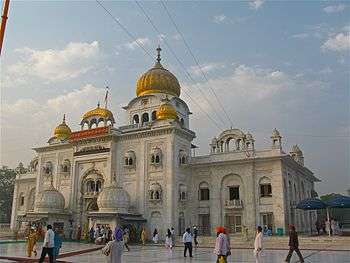Guru Har Krishan
| Guru Harkrishan ਗੁਰੂ ਹਰਿਕ੍ਰਿਸ਼ਨ ਜੀ | |
|---|---|
 A fresco of Guru Har Krishan ca. 1745 | |
| Born |
July 23, 1656 Kiratpur Sahib, Rupnagar, Punjab, Mughal Empire (Present day India) |
| Died |
March 30, 1664 (aged 7) Delhi, Mughal Empire (Present day India) |
| Other names |
The Eighth Master The Child Guru |
| Years active | 1656–1664 |
| Known for | Helping patients at Delhi |
| Predecessor | Guru Har Rai |
| Successor | Guru Tegh Bahadur |
| Spouse(s) | 0 |
| Children | 0 |
| Parent(s) | Guru Har Rai and Mata Krishen |
Guru Har Krishan ([ɡʊru həɾ kɾɪʃən]; 23 July 1656 – 30 March 1664) was the eighth of the ten Sikh Gurus. At the age of 5, he became the youngest Guru in Sikhism on 7 October 1661, succeeding his father, Guru Har Rai.[1]
He is also known as Bal Guru (Child Guru).[1] He died at age eight during an epidemic in Delhi, and his granduncle Guru Tegh Bahadur became the next Guru of the Sikhs.[1] He had the shortest tenure as Guru, lasting only 2 years, 5 months and 24 days.
Early days
Har Krishan was born in Kiratpur Sahib, Rupnagar, Punjab, Mughal Empire (Present day India) to Guru Har Rai and Kishan dei (Mata Sulakhni).[2]
Before His death in October 1661, Guru Har Rai designated his younger son Har Krishan as the next Guru. Guru Har Rai chose Har Krishan, rather than his elder son Ram Rai, because Ram Rai was in collusion with the Mughal Empire. Har Krishan was only five years old when he succeeded his father as Guru.
Attainment of Guruship
It is said that when Guru Har Rai was asked which of his two sons Ram Rai and Har Krishan would be the next guru, he said that although both of them followed the same religion and recited the same bani, there was softness in the heart of Har Krishan and Ram Rai was rough from the heart.
For the enlightenment of any person or to be named as the guru, softness was of prime importance. Thus, the next Guru came to be Guru Har Krishan at the age of 5, the youngest guru in Sikh history.
Notable Incidents
At Panjokhra Sahib, near Ambala, Haryana, there stands a magnificent gurudwara in memory of the miracle done by Guru Har Krishan. It is told [3] that doubting the abilities of a small child to be a Guru, a local pandit (learned man) challenged him to translate and explain the Sanskrit verses of Bhagvad Gita.
At that time, Sanskrit was read & studied only by literatre people. He brought with him a completely illiterate man with limited mental ability named Gangu Jheevar. Guruji pointed a stick on Gangu's head as a blessing and that disabled illiterate man started uttering the sermons of the sacred text to the perfection.
Final Days
When they reached Delhi, Guru Har Krishan and his party were the guests of Raja Jai Singh II. Every day, large numbers of Sikh devotees flocked to see the Guru.
An epidemic was then raging in Delhi. Guru Har Krishan helped to heal many sick people. Guru Har Krishan, being soft and kind hearted, served the ill and is said to have taken smallpox upon himself.
On March 30, 1664, Guru Har Krishan decided to name his successor. He called for five coins and a coconut. He took them, and being too weak to move, waved his hand three times in the air, and said Baba Bakala(Punjabi: ਬਾਬਾ ਬਕਾਲੇ), meaning his successor was to be found in Baba Bakala town. Guru Har Krishan then died of at the age of 8, as he had refused treatment.
One of the historic gurdwaras in India, the Bangla Sahib in Delhi, was built on the site where Guru Har Krishan helped the sick. Guru Har Krishan died at Gurudwara Bangla Sahib, Delhi.
Gallery
-

Gurudwara Bangla Sahib, where the Guru died
-

History of Gurudwara Panjokhra Sahib, Haryana
References
External links
- DiscoverSikhism - Sri Guru Harkrishan Sahib Sri Guru Harkrishan Sahib is the eighth of the Ten Sikh Gurus. Read about his life and stories here.
- Sikhs.org
- Sikh-History.com
- Shri Har Krishan Dhiaiyai Kirtan Shabad
- Sri Har Krishan Dhiaiyai - Video on Sri HarKrishan Sahib
- - Video on YouTube on Sri Guru HarKrishan
- srigurugranthsahib.org
- Learn more about Har Kishan
| Preceded by Guru Har Rai |
Sikh Guru 6 October 1661 - 30 March 1664 |
Succeeded by Guru Teg Bahadur |

